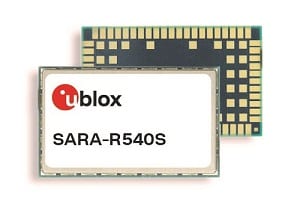The device provides robust communication technique for IoT ecosystems, ensuring high levels of availability and resilience
 The u-blox SARA-R540S can communicate on LTE bands 31, 72, 73, 87, and 88. These lower-frequency bands have good propagation characteristics, helping customers in the smart meter, public safety, smart grid and smart cities markets that require strict indoor and outdoor coverage requirements, which otherwise might be difficult to reach over standard cellular connectivity options.
The u-blox SARA-R540S can communicate on LTE bands 31, 72, 73, 87, and 88. These lower-frequency bands have good propagation characteristics, helping customers in the smart meter, public safety, smart grid and smart cities markets that require strict indoor and outdoor coverage requirements, which otherwise might be difficult to reach over standard cellular connectivity options.
The device services a growing trend to install dedicated communications infrastructure for IoT ecosystems, ensuring high levels of availability and resilience. For example, the shift to smart energy grids will demand close coordination of distributed renewable power plants and millions of demand-management controllers installed at customer premises. Therefore, robust communication infrastructure is needed.
The SARA-R540S is based on the u-blox UBX-R5 cellular chipset. Other hardware features include a high RF power output to ensure better reach of the SARA-R540S in places, such as within buildings. The module supports Power Class 3 transmission over standard LTE bands and Power Class 2, at an enhanced 26 dBm maximum output power, in the 450 MHz spectrum. The SARA-R540S also supports the 3GPP bands 87 and 88 in the 410 MHz spectrum, as well as dynamic antenna tuning to help designers achieve maximum efficiency and coverage.
The module has been tuned for energy efficiency, which is important for remote and battery-powered products, such as water meters and gas meters. The SARA-R540S draws less than 1 μA of current in power-saving mode and has a ‘last-gasp’ function to send a last message before it finally loses its power supply, for example, during a power outage or in case of a tampering event.
The SARA-R540S module also has the necessary hardware and software onboard to support u-blox’s IoT Security-as-a-Service strategy, ideal for devices that transmit critical and confidential information in, for example, industrial or infrastructure applications such as metering.
The module has a built-in hardware root of trust, which provides the foundation for secure authentication of the device in the field. It also implements a lightweight pre-shared key management system designed specifically for low-power wide-area (LPWA) applications to guarantee state-of-the-art security.






